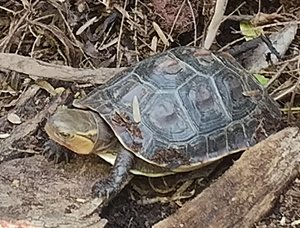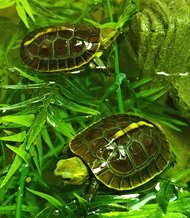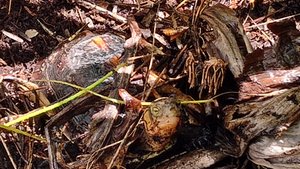
Chinese Box Turtle, yellow marginated box turtle, Ryukyu box turtle, golden-headed turtle, snake-eating turtle.
Cuora flavomarginata
Adult Size: 5-12 inches
Captive Lifespan: 25-40 years
Originating from the sub-tropical to temperate climate of Southern China, Taiwan, and various offshore islands, the range of the Chinese box turtle exposes this species to everything from hot, humid summers to wet, cold, harsh winters. Often they can be found living amongst the rice paddies, this semi-aquatic turtle is found in forests along the damp banks of streams and ponds.
These box turtles are small with domed shells. Adults have a dark brown shell with a cream-yellow strip down the middle of the vertebral scutes and along the lateral edges of the plastron. In addition to the keel down the vertebral scutes, many also possess lateral keels along the pleural scutes.
Now considered endangered, historically this species was collected in large numbers from the wild for the pet trade as well as being collected for the Chinese food markets, this species also faces pressure from habitat loss due to China’s rapid economic growth.
Personality-wise, these turtles are active and inquisitive. They quickly learn to recognize people as a food source and will often beg.

This species should be housed semi-aquatic in an enclosure that is 50% water and 50% land. Provide a shallow area of water with a depth of 7-20 cm (3-8 “). Shallower water should be provided for juveniles Humidity levels should remain between 60-70%.
Indoors: For one adult turtle an enclosure minimally 3’x2’ is recommended, but this active species appreciates more room if possible. Terrestrial waterland tubs or large aquariums work fine for this species as long as space, ventilation, and humidity is maintained.
Outdoors: Outdoor enclosures should be similar to that of indoors, making sure the enclosure is predator-proof. Mist as necessary to keep the substrate moist and provide plenty of safe water and terrestrial plants for security.
Indoors: sphagnum moss, peat moss, coconut coir
Outdoors: Peat moss, topsoil, sphagnum moss
Avoid: gravel, sand, cedar chips, pine shavings, aspen shavings
Indoor turtles should be provided a temperature gradient using heat lamps or radiant heat panels with a basking area of 85-95 degrees F and a cool end in the mid-70s. This species does well housed outdoors year-round in southern US climates where winter temperatures do not drop below 25 degrees F as during the winter months this species will bury themselves in the substrate and go dormant.

Turtles require UVB lighting to process calcium properly. UVB lighting should be provided using either fluorescent (tube or "spiral" bulbs) or mercury vapor bulbs designed specifically for use in reptiles. When selecting fluorescent bulbs the high-output 10.0 bulbs are recommended as tortoises require fairly high levels of UVB exposure. It should be noted that these bulbs will stop providing UVB long before they stop producing visible light so they will need to be changed regularly, usually every 6 to 12 months depending on the manufacturer's recommendations.
Water should be provided within the enclosure to replicate a shallow pond and make up minimally 50% of the enclosure.
This omnivorous species LIVES to eat. Their diet should mirror that of North American Box turtles and consist of both animal and vegetable matter. Animal matter that can be offered to box turtles includes: crickets, snails, slugs, earthworms, mealworms, low-fat cat food (such as Purina Kitten Chow), canned box turtle diets, and high-quality aquatic turtle pellets. Vegetables and fruits including, but not limited to dark leafy greens, dandelion greens, apples, strawberries, carrots, and squash should also be offered daily. All food should be dusted with a calcium supplement at least twice a week for turtles. A multivitamin that contains vitamin A should be dusted onto food twice a week. For more information on supplements click here. Offering a variety of food items helps ensure your turtles are receiving a balanced diet. Unlike North American Box turtles this species will gladly consume pellets and other food items placed in their water.
Provide multiple hide boxes throughout the enclosure as well as non-toxic terrestrial and aquatic plants
Droppings should be removed as soon as possible. Disinfect the enclosure regularly using either Rescue brand disinfectant or a mixture of 1 tablespoon bleach to 1 cup of water, make sure to rinse thoroughly after. Bowls should be disinfected at least weekly. The water area should be filtered using a fish tank or pond filter. Turtles are messier pets than fish so it’s best to choose a filter rated at least twice as big as the volume of water in the enclosure.
A relatively hardy turtle, the most common issue seen is developmental deformities secondary to a lack of appropriate humidity levels resulting in deformed shells and skulls. Thus, maintaining humidity levels is essential for this species, especially with juveniles.
Additional Information:
Copyright © All Rights Reserved